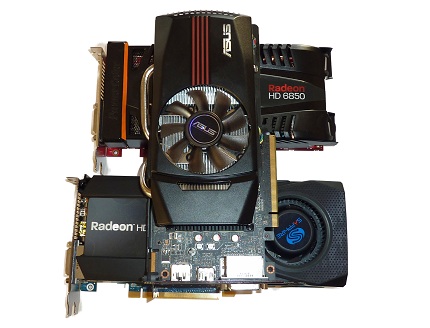How we test

GPU comparisons |
|||||||
|---|---|---|---|---|---|---|---|
| Graphics cards | Current pricing | GPU clock (MHz) | Stream processors | Shader clock (MHz) | Memory clock (MHz) | Memory bus (bits) | Graphics driver |
| Sapphire Radeon HD 5870 1,024MB | £235 | 850 | 1,600 | 850 | 4,800 | 256 | Catalyst 10.10P |
| HIS Radeon HD 5850 1,024MB | £180 | 725 | 1,440 | 725 | 4,000 | 256 | Catalyst 10.10P |
| HIS Radeon HD 6870 1,024MB | £185 | 900 | 1,120 | 900 | 4,200 | 256 | Catalyst 10.10P |
| Sapphire Radeon HD 6850 TOXIC 1,024MB | £165 | 820 | 960 | 820 | 4,400 | 256 | Catalyst 10.10 |
| PowerColor Radeon HD 6850 PCS+ 1,024MB | £160 | 820 | 960 | 820 | 4,400 | 256 | Catalyst 10.10 |
| ASUS Radeon HD 6850 DirectCu 1,024MB | £147 | 790 | 960 | 790 | 4,000 | 256 | Catalyst 10.10 |
| AMD Radeon HD 6850 1,024MB | £150 | 775 | 960 | 775 | 4,000 | 256 | Catalyst 10.10P |
| NVIDIA GeForce GTX 580 1,536MB | £399 | 772 | 512 | 1,544 | 4,008 | 384 | ForceWare 262.99 |
| ASUS GeForce GTX 480 1,536MB | £330 | 700 | 480 | 1,401 | 3,698 | 384 | ForceWare 262.99 |
| ASUS GeForce GTX 470 1,280MB | £180 | 607 | 448 | 1,215 | 3,348 | 320 | ForceWare 260.89 |
| Gigabyte
GeForce GTX 460 SOC 1,024MB |
£175 | 810 | 336 | 1,620 | 4,000 | 256 | ForceWare 262.99 |
| KFA
GeForce GTX 460 1,024MB |
£150 | 675 | 336 | 1,350 | 3,600 | 256 | ForceWare 260.89 |
| EVGA GeForce GTX 460 768MB | £125 | 675 | 336 | 1,350 | 3,600 | 192 | ForceWare 260.89 |
Test bench |
||||||||||||
|---|---|---|---|---|---|---|---|---|---|---|---|---|
| CPU | Intel Core i7 980X Extreme Edition (3.33GHz, 12MB L3 cache, hexa-core, LGA1366 - Turbo Boost enabled) | |||||||||||
| Motherboard | ASUS P6X58D Premium | |||||||||||
| Motherboard BIOS | 1002 | |||||||||||
| Memory | 6GB Corsair DDR3 | |||||||||||
| Memory timings and speed | 9-9-9-24-1T @ DDR3-1,600 | |||||||||||
| PSU | Corsair HX1000W | |||||||||||
| Monitor | Dell 30in 3007WFP - 2,560x1,600px | |||||||||||
| Disk drive(s) | Corsair Force F80 SSD | |||||||||||
| Operating system | Windows 7 Ultimate, 64-bit | |||||||||||
Benchmarks |
||||||||||||
|---|---|---|---|---|---|---|---|---|---|---|---|---|
| Aliens vs. Predator | DX11, 1,920x1,080 resolution, 2xAA, 16xAF, very high quality. | |||||||||||
| Just Cause 2 | DX10,1,920x1,080 resolution, 4xAA, 16xAF, Dark Tower benchmark | |||||||||||
| Mafia II | DX9, 1,920x1,080 resolution, AA on, 16x AF, built-in benchmark | |||||||||||
| Battlefield: Bad Company 2 | DX11, 1,920x1,080 resolution, 4xAA, 16xAF, ultra quality, FRAPS-recorded benchmark. | |||||||||||
| Call of Duty: Black Ops | DX9, 1,920x1,080 resolution, 4xAA, ultra quality, 16x AF, FRAPS-recorded benchmark. | |||||||||||
| Crysis Warhead | DX10, 1,920x1,080 resolution, 4xAA, gamer quality, Frost map, FRAPS-recorded benchmark. | |||||||||||
| DiRT 2 | DX11, 1,920x1,080 resolution, 4xAA, ultra quality, London map. | |||||||||||
| Civilization V | DX11, 1,920x1,080 resolution, 4xAA, high quality, lategameview benchmark | |||||||||||
| Temperature | To emulate real-world usage scenarios, we record GPU core temperature both when idle and whilst playing Call of Duty: Black Ops. And, for a worst-case scenario, we throw in numbers from the FurMark stress test. | |||||||||||
| Power consumption | To emulate real-world usage scenarios, we record mains power draw both when idle and whilst playing Call of Duty: Black Ops. And, for a worst-case scenario, we throw in numbers from the FurMark stress test. | |||||||||||
| Noise | A PCE-318 noise level meter is placed at the front of a Corsair 700D chassis, with side panel on. | |||||||||||
Pricing is taken as the lowest in-stock listing of any card in that particular family. A stock-clocked Radeon HD 5870 performs the same if it's from one company or another.
We've tried to be as all-inclusive as possible with this review of three retail cards. Appreciating the £150-£165 street price of the trio the obvious comparison is the GeForce GTX 460 1,024MB in both standard and pre-overclocked flavours. A KFA2 card does the honours for the bone-stock model, while the excellent Gigabyte GTX 460 SOC provides numbers for the overclocked part.
We've kept things simple and benchmarked at the 1,920x1,080 resolution across no less than eight games, bringing our old and new graphics-card suites together. Further, we've now included the madly-popular Call of Duty: Black Ops into the suite.
All cards have also been subjected to accurate noise measurement by way of a PCE-318 meter: the results are interesting.









